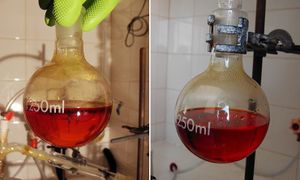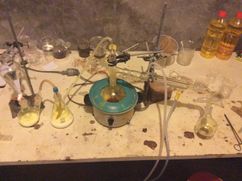Sulfur dichloride
 Photo by sciencemadness user len1
| |
| Names | |
|---|---|
| IUPAC names
Sulfur dichloride
Sulfur(II) chloride Dichlorosulfane | |
| Other names
Chlorine sulfide
Chloro thiohypochlorite Dichlorosulfide Sulphur chloride | |
| Properties | |
| SCl2 | |
| Molar mass | 102.97 g/mol |
| Appearance | Red fuming liquid |
| Odor | Pungent |
| Density | 1.621 g/cm3 (at 20 °C) |
| Melting point | −121.0 °C (−185.8 °F; 152.2 K) |
| Boiling point | 59 °C (138 °F; 332 K) |
| Reacts | |
| Solubility | Reacts with alcohols Soluble in glacial acetic acid, benzene, bromine, CCl4, chloroethane, cyclohexane, disulfur dichloride, hexane, phosgene Insoluble in liq. SO2 |
| Vapor pressure | 162 mmHg (at 20 °C) |
| Thermochemistry | |
| Std enthalpy of
formation (ΔfH |
493.9 kJ/mol |
| Hazards | |
| Safety data sheet | CPCB |
| Flash point | 118 °C |
| Related compounds | |
| Related compounds
|
Disulfur dichloride Thionyl chloride Sulfuryl chloride |
| Except where otherwise noted, data are given for materials in their standard state (at 25 °C [77 °F], 100 kPa). | |
| Infobox references | |
Sulfur dichloride (SCl2) is a foul smelling red liquid created through the reaction of sulfur and chlorine.
Contents
Properties
Chemical
Disulfur dichloride reacts with water to form sulfur dioxide and hydrochloric acid, so an open container will produce thick white fumes as it reacts with moisture in the air.
Sulfur dichloride slowly evolves chlorine, leaving disulfur dichloride unless the container can maintain a small positive pressure of chlorine.
Sulfur chlorides can be used to produce thionyl chloride.
Physical
SCl2 has a highly unpleasant odor, as well as producing HCl and SO2 which are also highly unpleasant to breathe in.
It is a bright red liquid with viscosity similar to water.
Availability
Due to air instability and pressure build-up from decomposition to the monochloride, sulfur dichloride is generally not available to buy.
Preparation
SCl2 distills over as chlorine is passed over molten sulfur. This reaction may also produce disulfur dichloride.
Both sulfur and chlorine are common chemicals in a home laboratory but the synthesis of sulfur dichloride is complicated as it requires simultaneous distillation while gassing the sulfur with the chlorine which requires moderately complicated glassware such as two necked flasks or a very well improvised setup.
An older method involves the reaction of sulfuryl chloride (which can be made by reacting dry sulfur dioxide and chlorine gas) with anhydrous zinc sulfide, in the presence of aluminium chloride.[1]
Projects
- Make thionyl chloride
- Make sulfur nitride
- Make anhydrous metal chlorides
Handling
Safety
Sulfur dichloride is extremely toxic and corrosive and proper protection must be worn when working with the compound. Work should be performed in a fumehood.
Storage
SCl2 should be stored in a sealed container, in a dry cold place. As it slowly decomposes over time, it's best to open the bottle from time to time to release the pressure.
Disposal
Reaction with water destroys the compound, and this can be effective if done outside or in an area capable of safely removing the sulfur dioxide. Aqueous sodium hydroxide solutions can also be used. Calcium hydroxide suspension is also a good choice. Be careful to only add the compound dropwise in a large amount of neutralizing solution.
See also
References
- ↑ Ruff, O.; Ber. Deutsch. Chem. Ges.; vol. 34; (1901); p. 1749 - 1758
